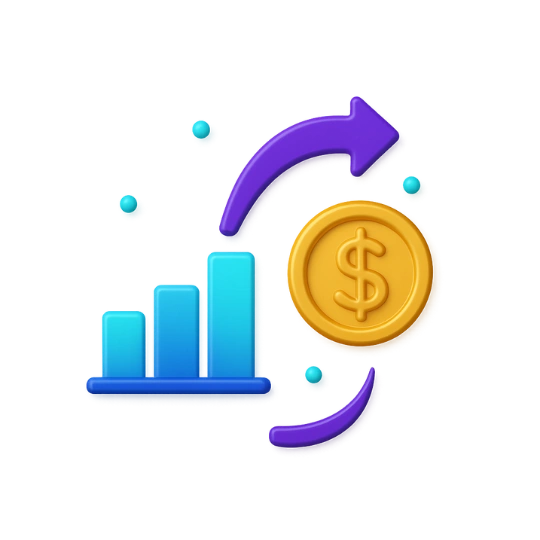Table of Content
Share This Article
- Published: Nov 21, 2025
- Last Updated: Nov 24, 2025
- 🔊 Listen
Quick Reads
- Smart financial reporting gives Brisbane SMEs clearer, faster visibility into what drives profit and what drains it.
- Reviewing the right financial reports helps business owners make better pricing, spending, and investment decisions.
- Clean month-end data reveals performance patterns that help SMEs control cash flow, margins, and operating costs.
- Understanding CAC, CLV, and ROI shows which customers and campaigns genuinely improve long-term returns.
- Outsourced accounting strengthens reporting accuracy and frees owners to focus on strategy instead of routine tasks.
Cash flow pressure, rising costs, and unpredictable sales cycles often leave Brisbane SMEs working harder just to stay ahead. Many owners rely on gut feeling instead of clear numbers, which leads to missed profit pockets and late decisions. Smart financial reporting cuts through the noise by giving you clean, timely insights that show where money is made, lost, or stuck. It helps you act with confidence and spot issues before they hit your margins.
In this blog, we will mention essential financial reports that can help your business master financial reporting and make needed strategies.

Fast, Reliable Financial Reporting
Delivering transparency and clarity in every report.
Top Financial Reports Every Brisbane Business Should Review to Track ROI
For SMEs in Brisbane, tracking key financial reports is essential. These include the balance sheet, cash flow statement, budget vs actual report, break-even analysis report, sales and revenue tracking report, expense analysis report, CAC, CLV, ROI by campaign, product or service margin reports, and asset utilisation reports. Let’s break down each financial report in detail.
Balance Sheet
The balance sheet helps local operators understand how much capital is tied up in equipment, vehicles, and leased sites, which are common cost centres across the city. It offers a clear read on borrowing levels and equity strength before taking on new projects or expansions.
Key formulas:
- Working Capital = Current Assets – Current Liabilities
- Current Ratio = Current Assets ÷ Current Liabilities
- Debt-to-Equity Ratio = Total Liabilities ÷ Total Equity
Cash Flow Statement
A cash flow statement is critical for businesses that experience timing gaps between issuing invoices and receiving payments, which is common across trades, construction, health services, and professional firms in the region. It shows how reliably cash circulates and where liquidity pressure builds and guides for cash flow forecasting further.
Key formulas:
- Free Cash Flow (FCF) = Operating Cash Flow – Capital Expenditure
- Operating Cash Flow Ratio = Operating Cash Flow ÷ Current Liabilities
Budget vs Actual Report
This report helps owners stay on top of fluctuating costs influenced by suppliers, labour, and seasonal demand patterns. By comparing planned numbers with actuals, it provides clarity on where overspending starts and keeps operational targets aligned with realistic trading conditions.
Key formulas:
- Variance = Actual – Budget
- Variance % = (Variance ÷ Budget) × 100
Break-Even Analysis Report
A break-even analysis is essential for businesses dealing with rising wages, increasing lease costs, or project-based delivery. It highlights the revenue level required to cover these expenses and helps decision makers evaluate if new service lines or pricing adjustments are commercially viable.
Key formulas:
- Break-Even Point (Units) = Fixed Costs ÷ (Selling Price – Variable Cost per Unit)
- Break-Even Point (Revenue) = Fixed Costs ÷ Contribution Margin Ratio
Sales & Revenue Performance Report
Sales and revenue reports show how demand shifts across different customer groups, suburbs, or service categories. They help owners identify which offerings are gaining traction, which ones are slowing, and where to direct effort for stronger, more predictable returns.
Key formulas:
- Revenue Growth % = ((Current Period Revenue – Prior Period Revenue) ÷ Prior Period Revenue) × 100
- Average Revenue per Customer (ARPC) = Total Revenue ÷ Number of Customers

Expense Analysis Report
An expense analysis provides clarity on overheads, supplier charges, and recurring cost patterns. This level of insight is particularly useful for businesses juggling fuel costs, compliance fees, and rising operating expenses, helping them make controlled adjustments without affecting delivery quality.
Key formulas:
- Expense % of Revenue = (Total Expenses ÷ Total Revenue) × 100
- Cost Reduction % = ((Old Cost – New Cost) ÷ Old Cost) × 100
Customer Acquisition Cost (CAC) Report
CAC reporting helps owners track how much they spend to secure a new customer through digital, referral, or local marketing channels. It reveals the true cost of growth and helps refine budgets so resources are channelled toward methods that consistently convert.
Key formulas:
- CAC = Total Sales & Marketing Spend ÷ Number of New Customers Acquired
- CAC Payback Period = CAC ÷ Monthly Gross Margin per Customer
Customer Lifetime Value (CLV) Report
CLV highlights which customers deliver the strongest long-term value, something many local service-based businesses rely on. It supports decisions around loyalty initiatives, client experience improvements, and retention strategies that lift profitability without pushing acquisition costs higher.
Key formulas:
- CLV (Basic) = Average Purchase Value × Purchase Frequency × Customer Lifespan
- CLV to CAC Ratio = CLV ÷ CAC
ROI by Campaign/Project Report
This report shows how well marketing campaigns or internal projects perform compared to their investment. It helps business owners stop spending on activities that look busy but deliver little return, and instead focus on the initiatives that reliably support growth.
Key formulas:
- ROI = ((Net Profit from Campaign – Campaign Cost) ÷ Campaign Cost) × 100
- Attribution ROI (If multi-channel) = (Attributed Revenue – Cost Per Channel) ÷ Cost Per Channel
Product or Service Margin Report
A margin report helps businesses understand which offerings remain profitable as operating costs shift. It gives a clear breakdown of high-performing lines, those that need pricing adjustments, and where operational tweaks can lift overall margin without affecting customer value.
Key formulas:
- Gross Margin % = ((Revenue – Cost of Goods Sold) ÷ Revenue) × 100
- Contribution Margin = Selling Price – Variable Cost per Unit
Asset Utilisation Report
For businesses operating machinery, tools, vehicles, or multi-site equipment, this report highlights how effectively those assets are being used. It supports smarter capital decisions by identifying assets that generate value and those that are underused or costing more than they return.
Key formulas:
- Asset Turnover Ratio = Revenue ÷ Total Assets
- Return on Assets (ROA) = Net Profit ÷ Total Assets
How Accounting Outsourcing Help Strengthens Your Financial Reporting
Outsourcing accounting can give your business access to skilled professionals, stronger compliance, audit-ready accuracy, and advanced technology that improves real-time visibility. It also cuts overheads and frees your team from routine work. Here’s a quick breakdown of how these benefits come together for Brisbane-based businesses.
- Gives you a skilled team familiar with Australian Accounting Standards (AASB) and regulatory expectations
- Reduces compliance risks tied to BAS, GST, Single Touch Payroll (STP), and superannuation reporting
- Ensures consistent month-end and year-end closes using standardised, audit-friendly processes
- Delivers accurate management reports, cash-flow statements, and budgeting packs tailored for Brisbane SMEs
- Supports multi-entity and multi-state reporting for businesses operating across different jurisdictions
- Uses advanced automation tools (Xero, MYOB, QuickBooks Online) to cut manual errors and speed up reconciliations
- Strengthens internal controls with clear segregation of duties and documented workflows
- Improves audit preparedness for external auditors and ATO reviews
- Gives real-time visibility through dashboards, KPI tracking, and industry-specific benchmarks
- Reduces overheads while freeing business owners to focus on forecasting, strategy, and growth
Turn Financial Insight into Better ROI with Dedicated Accounting Support
Smart financial reporting gives Brisbane SMEs the clarity they need to sharpen decisions, protect margins, and act at the right moment. When your numbers are clean, timely, and backed by proper analysis, it becomes easier to see what drives profit, what drains it, and where adjustments can lift returns. Pairing these insights with disciplined reporting routines gives your business a stronger financial base and a clearer path to better ROI.
Whiz Consulting helps Brisbane businesses strengthen their financial reporting with structured workflows, accurate month-end close, and real-time dashboards powered by leading cloud tools. Our accountants deliver tailored financial reporting services, variance insights, and data you can rely on for confident decision-making. If you want sharper visibility and a reporting system that actually supports growth, contact us and start building it!

Get customized plan that supports your growth
Have questions in mind? Find answers here...
Yes. The core ROI reports such as profitability, cash flow, margins and cost analysis apply to both. The metrics differ slightly, but the reporting helps any business understand performance and find improvement areas.
Most businesses check ROI monthly to stay on top of performance and cost shifts. If you are scaling, facing tight cash flow or running campaigns, a fortnightly review keeps decisions sharper.
They highlight where spending or revenue shifted from the plan. When gaps appear, you can adjust pricing, trim expenses or redirect resources, which strengthens your ROI over time.
Watch your gross margin, operating margin and job level profitability. If revenue is not growing at the same pace as expenses, your ROI is slipping even if sales appear steady.
Yes. Accounting software such as Xero, MYOB and QuickBooks track revenue, costs and margins well enough for basic ROI insights. For deeper analysis, you may need add ons or custom reports.
They clean your data, build clearer dashboards and highlight trends you might miss. They also benchmark performance, tighten controls and recommend actions that lift profitability and long term ROI.
Thousands of business owners trust Whiz to manage their account
Let us take care of your books and make this financial year a good one.




